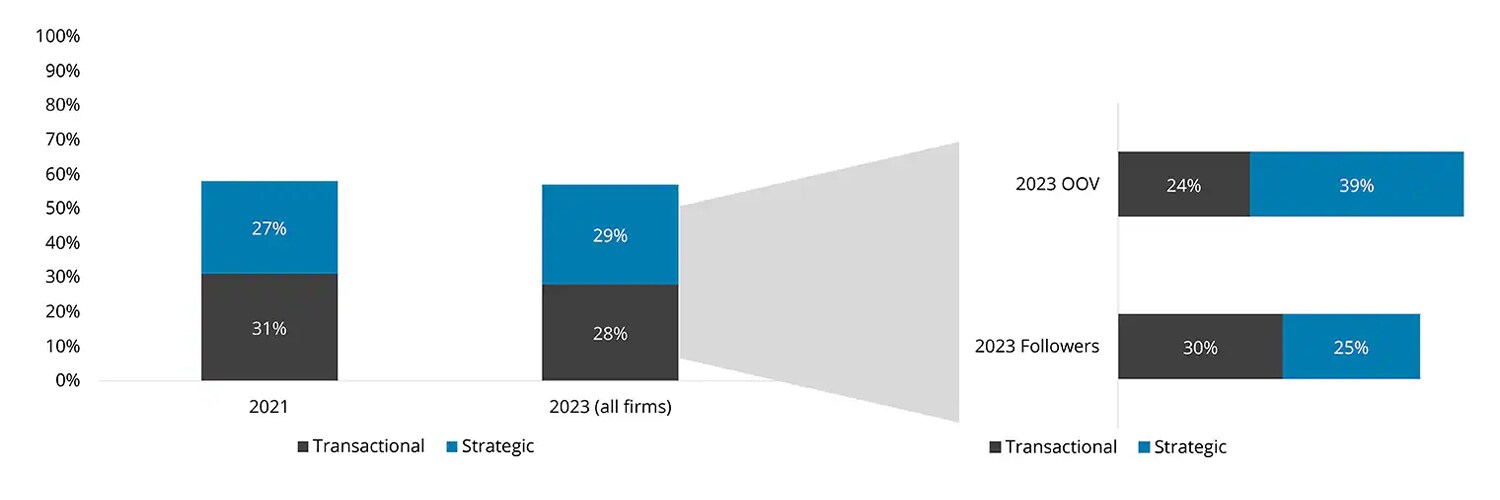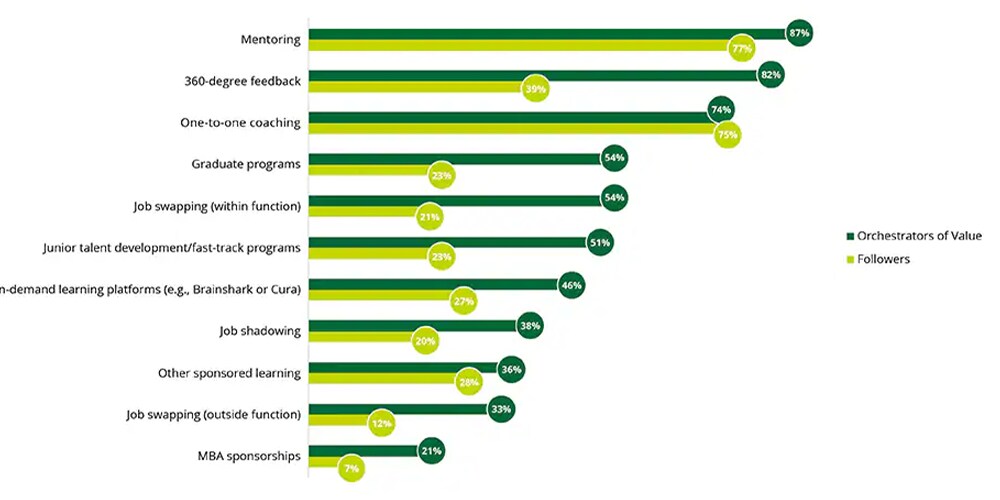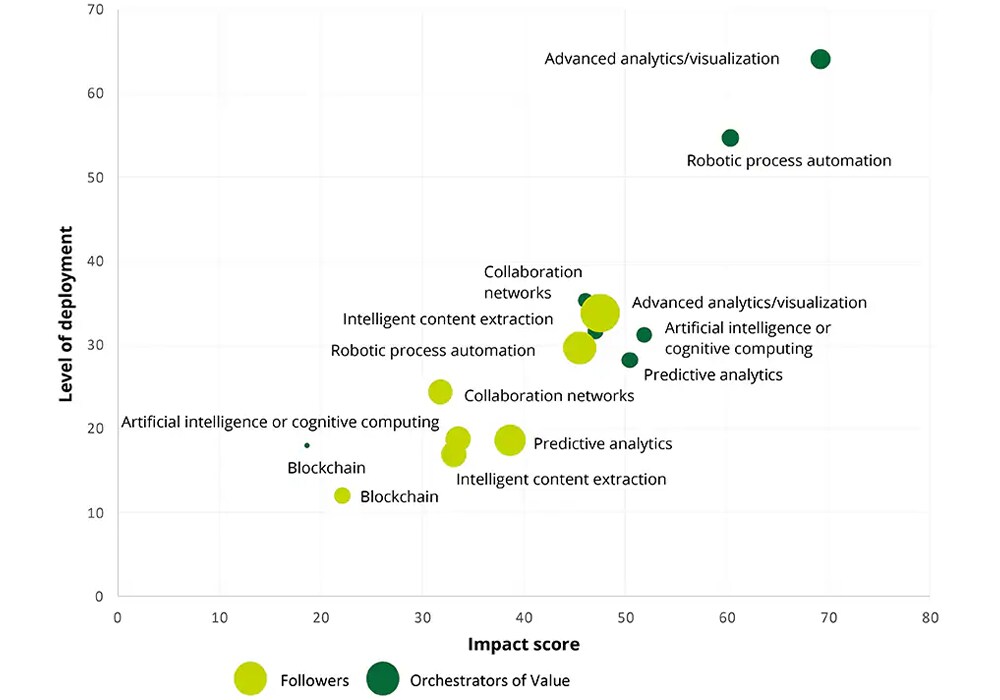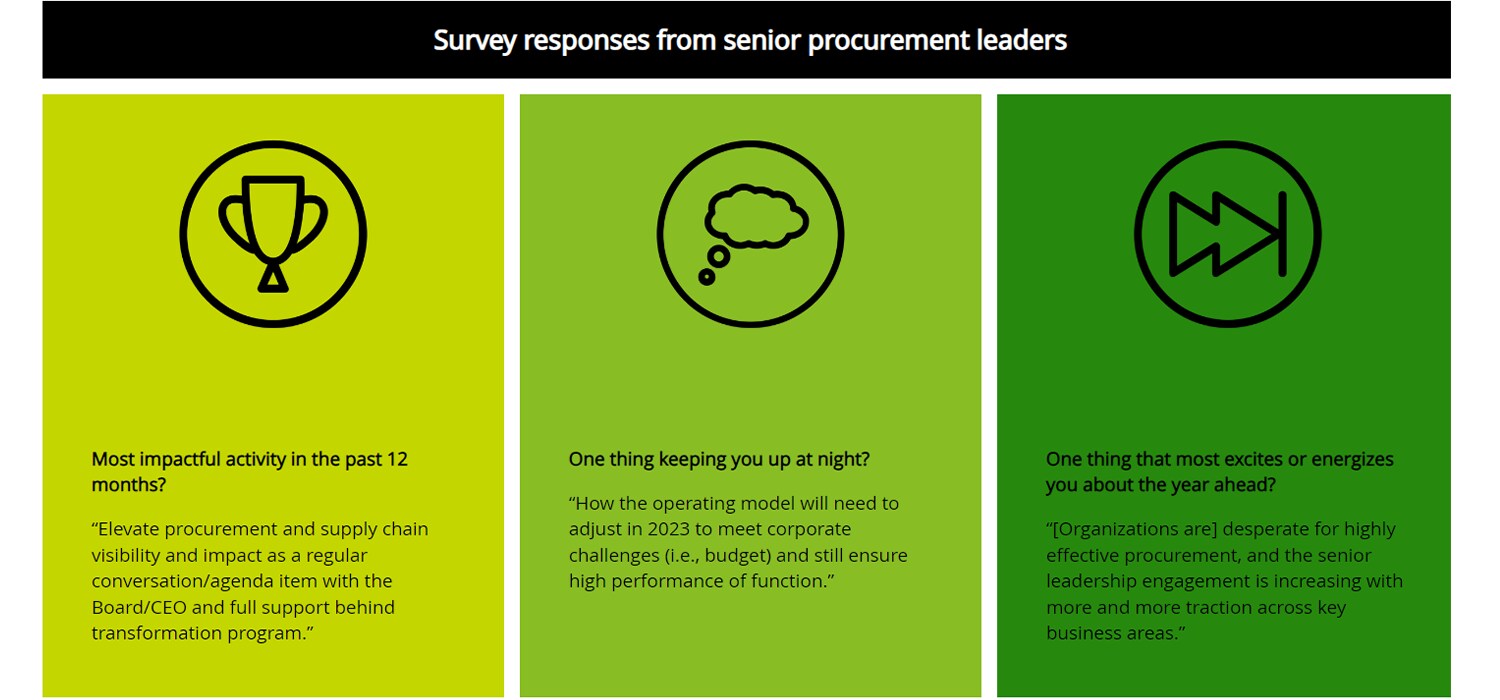2023 Global Chief Procurement Officer Survey has been saved

Article
2023 Global Chief Procurement Officer Survey
Observations, challenges, and trends in procurement
What capabilities and strategies are today’s most successful procurement organizations investing in? See observations and trends from our 2023 Global Chief Procurement Officer (CPO) Survey—based on the responses of almost 350 procurement leaders from more than 40 countries.
For almost 12 years across 10 editions of the Deloitte Global CPO Survey, CPOs have talked about procurement getting a seat at the table. Following the COVID-19 pandemic and the unprecedented levels of supply chain disruption as well as the growing need for procurement to enable growth, mitigate inflation, and drive significant levels of value, that day has finally come.
Introducing the survey
As we reflect on the responses of nearly 350 senior procurement leaders from more than 40 countries, we have identified the attributes and capabilities that the most successful procurement organizations have invested in. There is a clear imperative to build agility and resilience into supply chains (and other functions), and more specifically, we have uncovered how leading organizations are effectively delivering across the broader value proposition that seems to get broader every year.
Introducing Orchestrators of Value
This latest survey illustrates how these top-performing procurement teams are increasingly working with business unit leaders, functional partners, and suppliers to empower their teams to become “Orchestrators of Value” and get everyone playing off the same “score.” We found three main areas that Orchestrators of Value focus on to successfully deliver on their commitments while addressing challenges and constraints:
Organizational design-wise, there is a continued trend toward increased centralization of key capabilities—for example, business engagement, sourcing, contracting, risk management, and data and analytics (a roughly 15% increase across them since the 2021 survey). It’s important to note that standardization of policies, processes, systems, and data is again, by far, the top strategy to manage potential workload volatility and enable greater agility (increasing further since 2021). Orchestrators of Value apply this strategy 20% more often than “Followers” do. Orchestrators of Value also leverage hybrid operate service models 1.5x more than Followers further allowing them increased efficiency and agility.
The ability to effectively engage the business (peer functions and corporate leadership), build and leverage these trusted relationships to set common goals, and align on the support needed to deliver them can be the deciding factor in addressing funding and getting the greenlight to begin the transformation. We see Orchestrators of Value do this more effectively, and as a result, they are more often involved in the decision-making process regarding broader business priorities. They are more able to share and demonstrate the impact procurement can have on these top business priorities. To achieve this, Orchestrators of Value continually work to pull themselves out of transactional processes (and operational ones too) to focus more on the strategic (figure 1).
Figure 1. Allocation of time: Strategic vs. transactional ('operational' not shown)

Talent acquisition and retention is the most cited internal risk (four times higher than digital fragmentation). More than 70% of CPOs in our study had difficulty attracting talent over the past 12 months. Interestingly, the tightened labor market in general has proven to be concerning across the enterprise with top CEOs naming talent as the biggest challenge faced in the Winter 2023 Fortune/Deloitte CEO Survey.1 Addressing the scarcity of talent supply through traditional talent acquisition channels (e.g., hiring full-time staff) is a top strategy for nearly all firms. Procurement talent is one, if not the, key differentiator for CPOs—90% of Orchestrators of Value believe that their teams fully or largely have the skills and capabilities necessary to deliver their procurement strategy, with less than half of Followers in agreement.
The biggest takeaway on the talent side is the stark contrast between Orchestrators of Value and Followers when it comes to the talent development strategies they employ (figure 2). Knowing that talent is often hard to acquire, Orchestrators develop far more sophisticated talent programs that consider a much wider range of talent development techniques. Far from relying on mentoring and one-to-one coaching alone, they are twice as likely to employ a broader talent strategy inclusive of things such as 360-degree feedback, graduate programs, and job swapping. It’s hardly surprising they find it easier to attract and retain the top talent!
Figure 2. Talent develpment approaches

Digital transformation is the third most cited enterprise issue driving procurement priorities, and although procurement doesn’t typically influence the enterprise digital strategy itself, Orchestrators of Value are three times more likely to be involved than their peers. Regardless of the procurement function’s direct influence on the enterprise digital strategy itself, Orchestrators are heavily affected by their own need to digitize procurement in fulfillment of the broader enterprise goals. Nearly all CPOs understand the power of digitization, which is why digital transformation is the second most cited procurement strategy (behind supplier collaboration) and why 55% of Orchestrators of Value cite it as a “top 3” strategy (compared to just 36% of Followers).
Which technologies are getting deployed, and more importantly, what’s delivering the most value? Analytics and robotic process automation (RPA) are still at the top (figure 3), with analytics transcending descriptive business intelligence tools (e.g., for visualizations and dashboards) toward artificial intelligence/machine learning (AI/ML)-based predictive/prescriptive analytics. Orchestrators are applying these two technologies at roughly three times the rate of Followers (and having “fully deployed” AI solutions at 16 times and RPA at 10 times the rate of Followers).
Figure 3. Level of deployment of next gen technologies vs. impact score

Risk
CPOs have definitively indicated that risk is here to stay, as evidenced by the greater than 70% in our survey who indicated that procurement-related risk/supply chain disruption has increased in the past 12 months on top of an already elevated baseline. Overall procurement and supply-related risks have continued to increase. To understand that trend, in the 2023 study, 43% of CPOs cited overall procurement risk had increased significantly as compared to 20% in the 2021 study.
- Cost/spend risk (inflation) (89%) and supply shortages (79%) were the top two issues that had high or moderate impact over the past 12 months.
- Inflation risk is expected to continue and has surged to a “top 3” risk over the next 12 months.
- Only 25% of firms said that they could identify and predict supply disruptions in a timely manner “to a large extent” (63% “to some extent”).
- The loss of critical talent came in as the top internal issue, with 46% of CPOs citing it as a high or moderate risk.
- Internal complexity (e.g., organizational silos or nonstandard processes) was cited by more than 25% of CPOs as a “top 3” issue.
The great news is that many procurement organizations are rushing to help address these issues—not only to help mitigate supply risks and fight inflation risk, but also to respond to new requirements such as environmental, social, and governance (ESG), now the No. 2 enterprise priority.
Environmental, social, and governance (ESG)
ESG support is a critical C-suite issue for CPOs to support and one they should arguably be using to their advantage. It includes renewing ways to engage and collaborate with suppliers to balance cost, resiliency, ESG, and other factors.
CPOs must be proactive. All commercial firms measure financial profit, but 40% of CPOs stated their procurement organizations don’t define or measure their own set of relevant ESG factors, even though 60% do measure suppliers at some level on sustainability.
The big procurement focus seems to be on sustainability related to reducing emissions and waste: 62% of CPOs are targeting climate mitigation, but 72% are attacking waste reduction and material circularity that can help reduce costs and respond to market demand.
Environmental, social, and governance (ESG)
ESG support is a critical C-suite issue for CPOs to support and one they should arguably be using to their advantage. It includes renewing ways to engage and collaborate with suppliers to balance cost, resiliency, ESG, and other factors.
CPOs must be proactive. All commercial firms measure financial profit, but 40% of CPOs stated their procurement organizations don’t define or measure their own set of relevant ESG factors, even though 60% do measure suppliers at some level on sustainability.
The big procurement focus seems to be on sustainability related to reducing emissions and waste: 62% of CPOs are targeting climate mitigation, but 72% are attacking waste reduction and material circularity that can help reduce costs and respond to market demand.

Looking forward
We anticipate that the global business environment will continue to be volatile, uncertain, complex, and ambiguous. Development of operating models, investment in and access to the necessary talent, and enablement of digital capabilities to aid decision-making and execution will likely differentiate those who win from everyone else. We anticipate the performance and capability gaps will grow between procurement organizations that can proactively manage this current inflection point and make the necessary investment in transformation and those that don’t.


